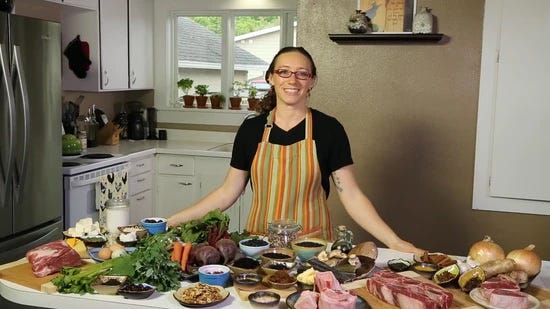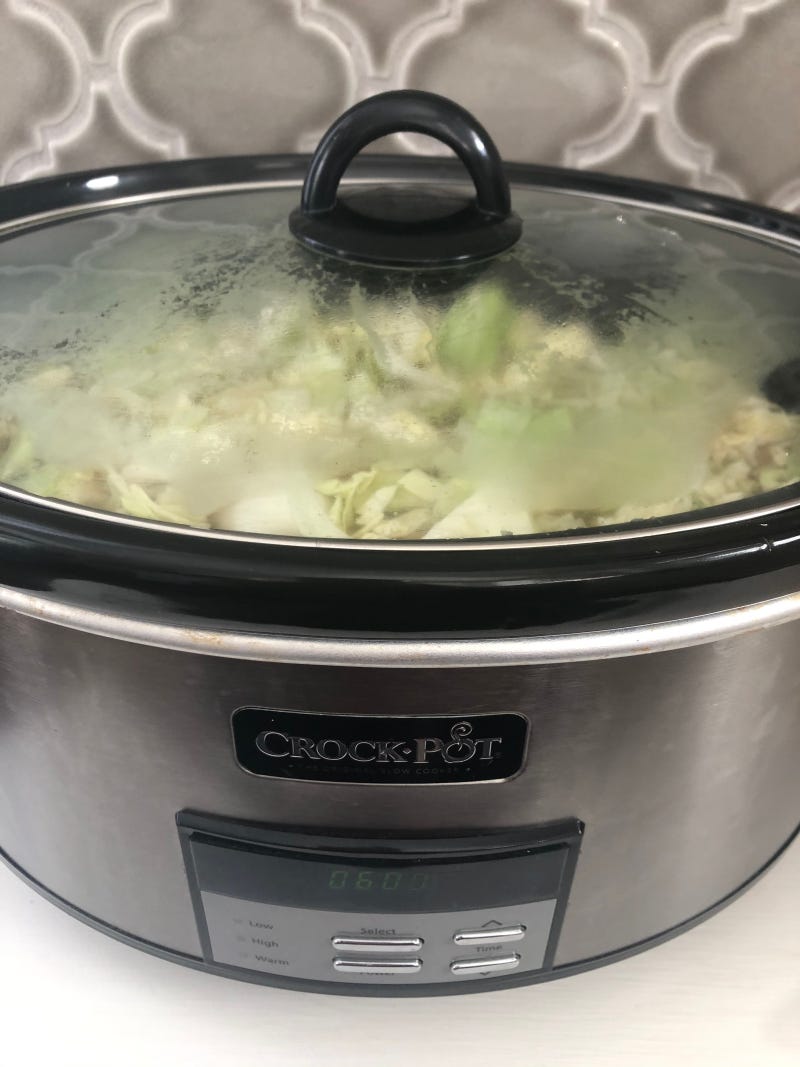Doin' the congee conga
A quick-and-easy crockpot dish that's perfect for the season. Plus, a special offer!
Congee is an Asian rice porridge. Never heard of it? Well, neither had I until a friend spirited me away to a delightful, unexpected place in Seattle’s International District called the Purple Dot Cafe, where I had my very first bowl of this heavenly dish.
Congee’s secret is a relatively low ratio of rice to water—and a slow cooking time. For this dish, I used 1 cup of rice to 10 cups of water instead of the usual 1:1.75. If that sounds like it might produce a bland-tasting ricey soup, never fear. Congee’s packed full of ginger, garlic, and onion, making it just the thing to eat in winter, especially as we begin to transition into spring. The recipe I’m using below is adapted from the Ancient Roots Nutrition video series, created by Lindsey Thompson, a licensed acupuncturist (full disclosure: she’s also my sister-in-law). Lindsey suggests congee as part of her cooking classes based in Chinese medicine. It’s my favorite of all the recipes in her video series, which I highly recommend. She also offers menu plans and self-care tips through her This Vital Life membership program.
Special Offer
Lindsey’s gifting Brunette Gardens readers 20% off both the video series and the nutrition support program membership. Just use this code at checkout:
BRUNETTEGARDENLOVE
Back to the congee: I had a whole head of cabbage I wanted to use—this porridge is full of it—and I was hankering for a bit of congee. Since I’m a few thousand miles away from the Purple Dot, that means I have to make it myself!
All right, on to the porridge.
Ingredients:
Half a head of cabbage (or more if you desire)
A half or whole white onion
Fresh ginger root
Anywhere from 3-8 cloves of garlic, to your preference
Soy sauce, tamari, or coconut sauce
1 cup of rice to 10 cups of water
Salt (optional)
1. First, dice at least half a head of cabbage and one onion. For this batch, I used a whole head of cabbage because I wanted to, but use what you want. As Lindsey says, “Congee is really forgiving,” so don’t sweat the exact amounts. You can dice them small if you prefer, but I like my vegetables chunky. Place these in the crockpot.
2. Next, grate a good amount of ginger into the crockpot. I added a whole, small-sized root. Depending on your love of ginger, you can use less—or more. Note I used a Microplaner to grate the ginger—I have to credit Lindsey for this tool as well, as I first heard about it from watching her video series. Microplaners come in multiple grate sizes meant for everything from nutmeg to cheese and are really handy to have in the kitchen.
3. You can add in garlic, too, and the same rule applies—as much or as little as you wish. We like garlic, and I tolerate it much better when it’s slow-cooked like this, so we went for a lot. Pro tip! Garlic cloves are way easier to peel if you pour boiling water over them first. I learned out about this from the first episode of the Netflix show Nadiya's Time to Eat (love her!). I was skeptical because every ‘easy tip for peeling garlic’ I’ve tried hasn’t really worked that well, but this one actually does!
Now for the garlic, I just use the traditional garlic crusher. I’ve had my OXO for going on eight years, and it works great. For me the Microplaner isn’t as useful because cloves are too small to grip without the risk of grating your finger.
4. Now for the rice. Like I said above, the ratio is 1 cup of rice to 10 cups of water. I used white basmati rice this time, but you can use any white rice. I’m not sure about brown, though; I think its “chewiness” might not work for congee. But feel free to experiment! If you do, tell us your results here in the comments.
Lindsey’s original recipe called for 10 cups of water. But it also contained fewer veggies, and since I went for the whole head of cabbage plus dialed up on the garlic and ginger, I added a couple of extra cups of water to compensate, for a total of 12. Remember, congee is forgiving! I’ve made crockpot congee numerous times and numerous ways, and it’s always turned out tasty and satisfying.
5. The last step is to season it with a bit of tamari, soy sauce, or coconut sauce. The coconut sauce is sweeter, so I add a bit of salt to bring it over to the umami side of the palate. Then you can start the crockpot, cooking it for 6-8 hours on low. Lindsey recommends eight, but I’ve had success at just six. Still, it’s good to know you can set this all up in the morning, work an 8-hour day, and come home to congee. It fills the house with the exhilarating aroma of garlic and ginger.
And it tastes great. Though it’s low in protein, you can drop an egg on it or eat it alongside a grass-fed beef patty, as we often do, to round out the meal. You could even top it with crumbled bacon, ham, seeds, nuts, or cheese.
So there you have it: crockpot congee! But if you’re ever in Seattle, I recommend heading to the Purple Dot to get your congee fix. You’ll be glad you did.
Here’s a handy, printable PDF of the above recipe.
This post contains affiliate links; if you purchase via the links, Brunette Gardens might earn a small commission at no extra cost to you.













Yum!